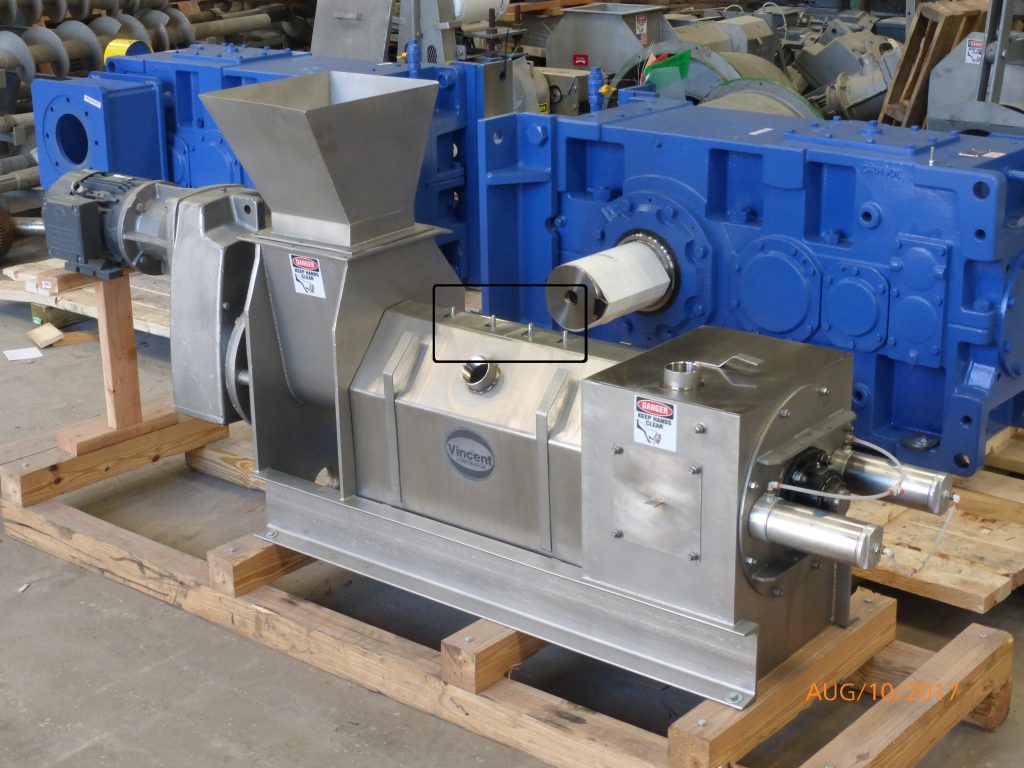September 10, 2017
Revised October 2018

TYPICAL HEMP PRESS: SEMI-VAPOR-TIGHT, EXPLOSION PROOF MOTOR, SCREEN AND CAKE DISCHARGE COVERS HAVE VENTING HALF COUPLINGS. NOTE FOUR FLUID INJECTION PORTS FOR IN-LINE WASHING (CIRCLED IN BOX).
Because of the trend toward alcohol extraction, Vincent is enjoying a surge of demand for presses used in processing cannabis. Over sixty are in service.
Cannabis sativa is a genus of plants that includes hundreds of varieties. One species group is known as industrial hemp, which is grown for fiber which is used in clothing, rope, and construction.
Two major groupings of cannabis have popular names in the press. One is “medicinal hemp” or “nutraceutical”, which it used for the extraction of CBD. The other is “recreational marijuana”, which is used for the production of THC.
With the trend toward legalization, the industry has become a lot more scientific.
Defining which of these two categories a plant falls into has been hard to nail down. The best, and most common, is that any cannabis with more than 0.3% THC falls in the THC category. This 0.3% limit came from work of a Canadian researcher, Ernest Small, in 1971. The limit is arbitrary, but it is the most common benchmark used in legislation.
CBD is cannabidiol extracted from hemp oil. It is non-psychoactive; it does not cause a high. It is extracted from hemp and sold, generally without legal restrictions. Discovered in the 1980’s, it appears to affect the body’s homeostasis, influencing mood, sleep, appetite, hormone regulation and pain and immune response. It is used most commonly for treating epileptic seizures in children, eating disorders, and general aches and pains.
THC is Δ-9 tetrahydrocannabinol, an intoxicant. That is the compound that gives you a high. Since it has the medicinal characteristic of easing pain, it is the one being prescribed as a medicine.
The industrial processing of cannabis involves extracting oils which contain either CBD or THC. Originally all the research work was done in small quantities in laboratories. This led to extraction using butane, hexane, or supercritical carbon dioxide. All of these have well known limitations. Hexane and butane are dangerous chemicals to work with, and supercritical carbon dioxide requires expensive equipment and has low-quantity throughputs. Because of this we are seeing a trend is toward alcohol extraction.
Vincent presses have a long history of being used with alcohol extraction. Mixed with alcohol, the chemical ingredients in cannabis are diffused into the alcohol. This ethanol can then be expelled from the hemp fiber using a screw press. Typically our Series CP screw presses are being used, the most common machine being the small CP-4.
Here are two links to short videos showing one in operation:
CANNABIS https://www.youtube.com/watch?v=u0qs0iWUFCs
This video was made in Tampa (with lawn clippings) for showing in our booth at the recent cannabis show in New York:
ALCOHOL & GRASS https://www.youtube.com/watch?v=3YjdYW1gbH4
Issue 299
